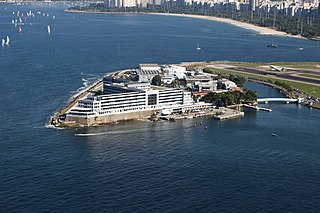
South Atlantic tropical cyclones are unusual weather events that occur in the Southern Hemisphere. Strong wind shear, which disrupts the formation of cyclones, as well as a lack of weather disturbances favorable for development in the South Atlantic Ocean, make any strong tropical system extremely rare, and Hurricane Catarina in 2004 is the only recorded South Atlantic hurricane in history. South Atlantic storms have developed year-round, with activity peaking during the months from November through May in this basin. Since 2011, the Brazilian Navy Hydrographic Center has assigned names to tropical and subtropical systems in the western side of the basin, near the eastern coast of Brazil, when they have sustained wind speeds of at least 65 km/h (40 mph), the generally accepted minimum sustained wind speed for a disturbance to be designated as a tropical storm in the North Atlantic basin. Below is a list of notable South Atlantic tropical and subtropical cyclones.
Each officer rank in the navy of a NATO country may be compared with the ranks used by any military service in other NATO countries, under a standardized NATO rank scale. This is useful, for instance, in establishing seniority amongst officers serving alongside each other within multinational command structures.
This table shows the ranks and insignia of NCOs and Seaman in the navies of member countries of NATO. NATO maintains a "standard rank scale" in an attempt to match every member country's military rank to corresponding ranks used by the other members. The rank categories were established in the document STANAG 2116, formally titled NATO Codes for Grades of Military Personnel.

The Naval School is a higher education military academy which aims to train officers for the Brazilian Navy. It is located in Rio de Janeiro, on Villegagnon Island just inside of Guanabara Bay.

This article presents the insignia and ranks of the Brazilian military. The insignia and ranks of the Brazilian military are defined by Act no. 6880 of December 9, 1980. The following ranks show Brazil's military insignia and its corresponding NATO codes.
The military ranks of Portugal form the system of hierarchical relationships in the Portuguese Armed Forces.
Rank comparison chart of all navies of European states.
Rank comparison chart of navies of North and South American states.
Rank comparison chart of navies of North and South American states.
Rank comparison chart of all navies of European states. Some European countries do not have naval forces, either because they are landlocked Austria, Belarus, the Czech Republic, Moldova, Luxembourg, Bosnia & Herzegovina, Kosovo, Slovakia, San Marino and the Vatican, or naval duties provided by another state such as Monaco, .
Rank comparison chart of navies of African states.
Rank comparison chart of non-commissioned officers and other personnel for navies of African states.
The Military ranks of Angola are the military insignia used by the Angolan Armed Forces.

The Tamandaré class are a new class of future general purpose frigates for the Brazilian Navy, based on the MEKO family of ships. The project is being developed by the Ministry of Defence and the Águas Azuis consortium, composed of Thyssenkrupp Marine Systems (TKMS) and Embraer Defense & Security. The construction of the four planned frigates will begin in 2021 and are scheduled to be delivered between 2025 and 2028.
The Brazilian Navy has a large number of active and planned projects, under the modernization plans of the Brazilian Armed Forces, defined in the National Defense White Paper. From 2010, Brazil started a radical change in its military policy, aiming to consolidate itself as the major power of Latin America, then the country's military strategists saw the great importance in modernize the Navy, both in terms of global projection and deterrence against possible threats to national interests by foreign powers from the year 2040, the total estimated budget for the plan was estimated in US$ 119 billion in 2010.
The Brazilian Submarine Force Command, is the submarine force of the Brazilian Navy. The ComForS is one of the most old commands of the Brazilian Armed Forces.
The Brazilian Navy General Staff is the general management body responsible for the coordination of the Brazilian Navy, the sea force of the Brazilian Armed Forces.
Rank comparison chart of officers for navies of Lusophone states.































